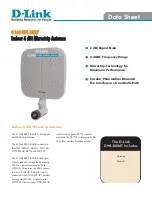
Page 6-8
ATU-HP Technical Instruction Manual
Issue 2.0
Section 6 Theory of Operation
6.3.6.3 Digital Outputs
8-bit shift registers U1, U2, U4, and their
associated components perform the
conditioning required to produce digital
outputs. The digital outputs consist of 17
status/alarm LEDs, four motor control
outputs and two fan control outputs. These
outputs are shifted out of U8, using its SPI
bus, into U1, U2, and U4. U8 pin 26 is used
to latch the current values to U1, U2, and
U4.
6.3.6.3.1
Status/alarm LEDs include
INHB
L TUNING
(DS10),
INHB R TUNING
(DS17),
LOCAL
(DS1),
TUNE SETUP
(DS3),
INCREASE R
(DS13),
DECREASE
R
(DS15),
NORMAL R
(DS14),
INCREASE
L
(DS6),
DECREASE L
(DS8),
NORMAL L
(DS7),
FAN FAIL 1
(DS19),
FAN FAIL 2
(DS21),
R MAX LIMIT
(DS12),
R MIN LIMIT
(DS16),
L MAX LIMIT
(DS5),
L MIN LIMIT
(DS9) and
XMTR OFF
(DS2).
6.3.6.3.2
Transistors Q14, Q15 and
associated components control the operation
of fan 1 (B2). When U4-2 switches high, Q14
turns on, Q15 turns on and the
+V_Fan
voltage is applied to the
Fan Control 1
output, causing the fan to turn on. When
U4-2 switches low, Q14 turns off, Q15 turns
off and the +V_Fan voltage is not applied to
the
Fan Control 1
output, causing the fan to
turn off.
6.3.6.3.3
Transistors Q13, Q16 and
associated components control the operation
of fan 2 (B3). When U4-1 switches high, Q13
turns on, Q16 turns on and the
+V_Fan
voltage is applied to the
Fan Control 2
output, causing the fan to turn on. When
U4-1 switches low, Q13 turns off, Q16 turns
off and the
+V_Fan
voltage is not applied to
the
Fan Control 2
output, causing the fan to
turn off.
6.3.6.3.4
If the fans have been enabled by
the microcontroller, the
Fan 1 Count
and
Fan 2 Count
inputs (see paragraph
6.3.6.2.8) are active. If the fan count ceases
for longer than ten seconds, a
FAN FAIL
(
1
or
2
) alarm will be generated and the fan
(B2 or B3) will be turned off by the
microcontroller.
6.3.6.3.5
Transistors Q1 through Q12 and
associated components form four identical
circuits that control the inductive and
resistive tune motors. For simplicity, only
the inductive tune motor’s control circuitry
will be described.
6.3.6.3.6
During tuned conditions, the
microcontroller applies low
Inc_L_Servo
and
Dec_L_Servo
outputs to the base of
Q12 and Q11, causing the transistors to
turn off. Q8 and Q7 will turn on, causing Q4
and Q3 to turn on. Since the same potential
(+12 V) is being applied to the
INCREASE
L
(TB1-9) and
DECREASE L
(TB1-10)
outputs, current will not flow through
inductive tune motor B1.
6.3.6.3.7
If the
Inc_L
microcontroller input
from the servo probe is higher than the
Dec_L
input, the microcontroller will
generate a high
Inc_L_Servo
output and
turn on the
INCREASE L
LED. Q12 turns
on. Q8 turns off, which causes Q4 to turn
off. A ground potential is applied, via Q12,
to the
INCREASE L
(TB1-9) output.
Inductive tune motor B1 will be active and
cause an increase in the loading coil
inductance.
6.3.6.3.8
If the
Dec_L
microcontroller input
from the servo probe is higher than the
Inc_L
input, the microcontroller will generate
a high
Dec_L_Servo
output and turn on the
DECREASE L
LED. Q11 turns on. Q8 turns
off, which causes Q3 to turn off. A ground
potential is applied, via Q11, to the
DECREASE L
(TB1-10) output. Inductive
tune motor B1 will be active and cause a
decrease in the loading coil inductance.
6.3.6.3.9
If either of the
L Limit Max
or
L
Limit Min
inputs are active (high), then the
appropriate
Inc_L_Servo
or
Dec_L_Servo
outputs will be held low (disabled) by the
microcontroller.
6.3.6.3.10
Motor control for the resistive
tune motor (A2B1) is similar to the
descriptions in paragraphs 6.3.6.3.6 through
6.3.6.3.9.
















































